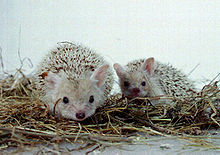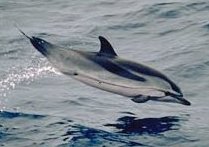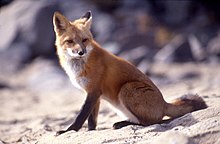You can help expand this article with text translated from
the corresponding article in Spanish. Click [show] for important translation instructions.
|
This is a list of the mammal species recorded in Cyprus. There are seventeen mammal species native to Cyprus, excluding feral species. [1] Most of the land mammals have been introduced, with only the Cypriot mouse being endemic. The other mammal species present on the islands during the Late Pleistocene, including the Cyprus dwarf hippopotamus, the Cyprus dwarf elephant, and Cyprus genet, are extinct.
The following tags are used to highlight each species' conservation status as assessed by the International Union for Conservation of Nature:
| EX | Extinct | No reasonable doubt that the last individual has died. |
| EW | Extinct in the wild | Known only to survive in captivity or as a naturalized populations well outside its previous range. |
| CR | Critically endangered | The species is in imminent risk of extinction in the wild. |
| EN | Endangered | The species is facing an extremely high risk of extinction in the wild. |
| VU | Vulnerable | The species is facing a high risk of extinction in the wild. |
| NT | Near threatened | The species does not meet any of the criteria that would categorise it as risking extinction but it is likely to do so in the future. |
| LC | Least concern | There are no current identifiable risks to the species. |
| DD | Data deficient | There is inadequate information to make an assessment of the risks to this species. |
Order: Lagomorpha (rabbits and hares)
Despite their appearance, lagomorphs are not rodents, and fall in their own order. They consist of rabbits, hares, and pikas.
Order: Rodentia (rodents)
Rodents make up the largest order of mammals, with over 40% of mammalian species. They have two incisors in the upper and lower jaw which grow continually and must be kept short by gnawing. Most rodents are small though the capybara can weigh up to 45 kg (99 lb).
- Suborder:
Sciurognathi
- Family:
Muridae (mice, rats, voles, gerbils, hamsters, etc.)
- Subfamily:
Deomyinae
- Genus:
Acomys
- Cyprus spiny mouse, A. nesiotes DD [3]
- Genus:
Acomys
- Subfamily:
Murinae
- Genus:
Mus
- Cypriot mouse, M. cypriacus LC
- House mouse, M. musculus LC introduced
- Genus: Rattus
- Genus:
Mus
- Subfamily:
Deomyinae
- Family:
Muridae (mice, rats, voles, gerbils, hamsters, etc.)
Order: Erinaceomorpha (hedgehogs and gymnures)

The order Erinaceomorpha contains a single family, Erinaceidae, which comprise the hedgehogs and gymnures. The hedgehogs are easily recognised by their spines while gymnures look more like large rats.
- Family:
Erinaceidae (hedgehogs)
- Subfamily:
Erinaceinae
- Genus:
Hemiechinus
- Long-eared hedgehog, H. auritus LC
- Genus:
Hemiechinus
- Subfamily:
Erinaceinae
Order: Soricomorpha (shrews, moles, and solenodons)
The "shrew-forms" are insectivorous mammals. The shrews and solenodons closely resemble mice while the moles are stout-bodied burrowers.
- Family:
Soricidae (shrews)
- Subfamily:
Crocidurinae
- Genus:
Crocidura
- Lesser white-toothed shrew, C. suaveolens LC introduced [4]
- Genus:
Suncus
- Etruscan shrew, S. etruscus LC
- Genus:
Crocidura
- Subfamily:
Crocidurinae
Order: Chiroptera (bats)
The bats' most distinguishing feature is that their forelimbs are developed as wings, making them the only mammals capable of flight. Bat species account for about 20% of all mammals.
- Family:
Pteropodidae (flying foxes, Old World fruit bats)
- Subfamily:
Pteropodinae
- Genus:
Rousettus
- Egyptian fruit bat, R. aegyptiacus LC [5]
- Genus:
Rousettus
- Subfamily:
Pteropodinae
- Family:
Vespertilionidae
- Subfamily:
Miniopterinae
- Genus:
Miniopterus
- Common bent-wing bat, M. schreibersii VU [6]
- Genus:
Miniopterus
- Subfamily:
Myotinae
- Genus:
Myotis
- Greater mouse-eared bat, M. myotis LC [7]
- Genus:
Myotis
- Subfamily:
Vespertilioninae
- Genus:
Pipistrellus
- Common pipistrelle, P. pipistrellus LC [8]
- Genus:
Plecotus
- Grey long-eared bat, P. austriacus NT [9]
- Genus:
Pipistrellus
- Subfamily:
Miniopterinae
- Family:
Rhinolophidae
- Subfamily:
Rhinolophinae
- Genus:
Rhinolophus
- Blasius's horseshoe bat, R. blasii LC [10]
- Mediterranean horseshoe bat, R. euryale NT [11]
- Greater horseshoe bat, R. ferrumequinum LC [12]
- Genus:
Rhinolophus
- Subfamily:
Rhinolophinae
Order: Cetacea (whales)

The order Cetacea includes whales, dolphins and porpoises. They are the mammals most fully adapted to aquatic life with a spindle-shaped nearly hairless body, protected by a thick layer of blubber, and forelimbs and tail modified to provide propulsion underwater.
Species listed below also includes species being recorded in Levantine Sea.
- Suborder:
Mysticeti
- Family:
Balaenopteridae
- Genus:
Balaenoptera
- Common minke whale, B. acutorostrata LC [13]
- Fin whale, B. physalus EN
- Genus:
Balaenoptera
- Family:
Balaenopteridae
- Subfamily:
Megapterinae
- Genus:
Megaptera
- Humpback whale, M. novaeangliae LC [14]
- Genus:
Megaptera
- Suborder:
Odontoceti
- Family:
Physeteridae
- Genus:
Physeter
- Sperm whale, P. macrocephalus VU [15]
- Genus:
Physeter
- Family:
Ziphidae
- Genus:
Mesoplodon
- Gervais' beaked whale, M. europaeus DD
- Genus:
Ziphius
- Cuvier's beaked whale, Z. cavirostris LC
- Genus:
Mesoplodon
- Superfamily:
Platanistoidea
- Family:
Delphinidae (marine dolphins)
- Genus:
Delphinus
- Short-beaked common dolphin, D. delphis DD
- Genus:
Globicephala
- Long-finned pilot whale, G. melas DD
- Genus:
Grampus
- Risso's dolphin, G. griseus DD
- Genus:
Orcinus
- Orca, O. orca DD
- Genus:
Pseudorca
- False killer whale, P. crassidens DD
- Genus:
Stenella
- Striped dolphin, S. coeruleoalba VU
- Genus:
Steno
- Rough-toothed dolphin, S. bredanensis LC [16]
- Genus:
Tursiops
- Common bottlenose dolphin, T. truncatus LC
- Genus:
Delphinus
- Family:
Delphinidae (marine dolphins)
- Family:
Physeteridae
Order: Carnivora (carnivorans)

There are over 260 species of carnivorans, the majority of which feed primarily on meat. They have a characteristic skull shape and dentition.
- Suborder: Caniformia
Order: Artiodactyla (even-toed ungulates)
The even-toed ungulates are ungulates whose weight is borne about equally by the third and fourth toes, rather than mostly or entirely by the third as in perissodactyls. There are about 220 artiodactyl species, including many that are of great economic importance to humans.
- Family: Bovidae (cattle, antelope, sheep, goats)
See also
References
- ^ This list is derived from the IUCN Red List which lists species of mammals and includes those mammals that have recently been classified as extinct (since 1500 AD). The taxonomy and naming of the individual species is based on those used in existing Wikipedia articles as of 21 May 2007 and supplemented by the common names and taxonomy from the IUCN, Smithsonian Institution, or University of Michigan where no Wikipedia article was available.
- ^ Johnston, C.H.; Robinson, T.J.; Child, M.F. & Relton, C. (2019). "Lepus capensis". IUCN Red List of Threatened Species. 2019: e.T41277A45186750.
- ^ Gerrie, R. & Kennerly, R. (2019). "Acomys nesiotes". IUCN Red List of Threatened Species. 2019: e.T271A2789136. Retrieved 9 September 2021.
- ^ Hutterer, R.; Amori, G.; Krystufek, B.; Yigit, N.; Mitsain, G. & Palomo, L.J. (2010). "Crocidura suaveolens". IUCN Red List of Threatened Species. 2010: e.T29656A9511068.
- ^ Korine, C. (2016). "Rousettus aegyptiacus". IUCN Red List of Threatened Species. 2016: e.T29730A22043105.
- ^ Gazaryan, S.; Bücs, S. & Çoraman, E. (2021) [errata version of 2020 assessment]. "Miniopterus schreibersii". IUCN Red List of Threatened Species. 2020: e.T81633057A19585652.
- ^ Coroiu, I.; Juste, J. & Paunović, M. (2016). "Myotis myotis". IUCN Red List of Threatened Species. 2016: e.T14133A22051759.
- ^ Godlevska, L.; Bücs, S.; Kruskop, S.V.; Gazaryan, S.; Benda, P. & Paunović, M. (2021) [errata version of 2020 assessment]. "Pipistrellus pipistrellus". IUCN Red List of Threatened Species. 2020: e.T85333513A196581936.
- ^ Gazaryan, S. & Godlevska, L. (2020) [amended version of 2020 assessment]. "Plecotus austriacus". IUCN Red List of Threatened Species. 2020: e.T85533333A195862345.
- ^ Taylor, P. (2016). "Rhinolophus blasii". IUCN Red List of Threatened Species. 2016: e.T19515A21972073.
- ^ Juste, J. & Alcaldé, J. (2016). "Rhinolophus euryale". IUCN Red List of Threatened Species. 2016: e.T19516A21971185.
- ^ Piraccini, R. (2016). "Rhinolophus ferrumequinum". IUCN Red List of Threatened Species. 2016: e.T19517A21973253.
- ^ Update on the Cetacean Fauna of the Mediterranean Levantine Basin
- ^ Are humpback whales electing the Mediterranean Sea as new residence?
- ^ Whale spotted off Larnaca
-
^ Kiszka, J.; Baird, R. Bearzi, G. & Braulik, G. (2020) [errata version of 2019 assessment].
"Steno bredanensis".
IUCN Red List of Threatened Species. 2019: e.T20738A178929751.
{{ cite journal}}: CS1 maint: multiple names: authors list ( link)
External links
- "Animal Diversity Web". University of Michigan Museum of Zoology. 1995–2006. Retrieved 22 May 2007.